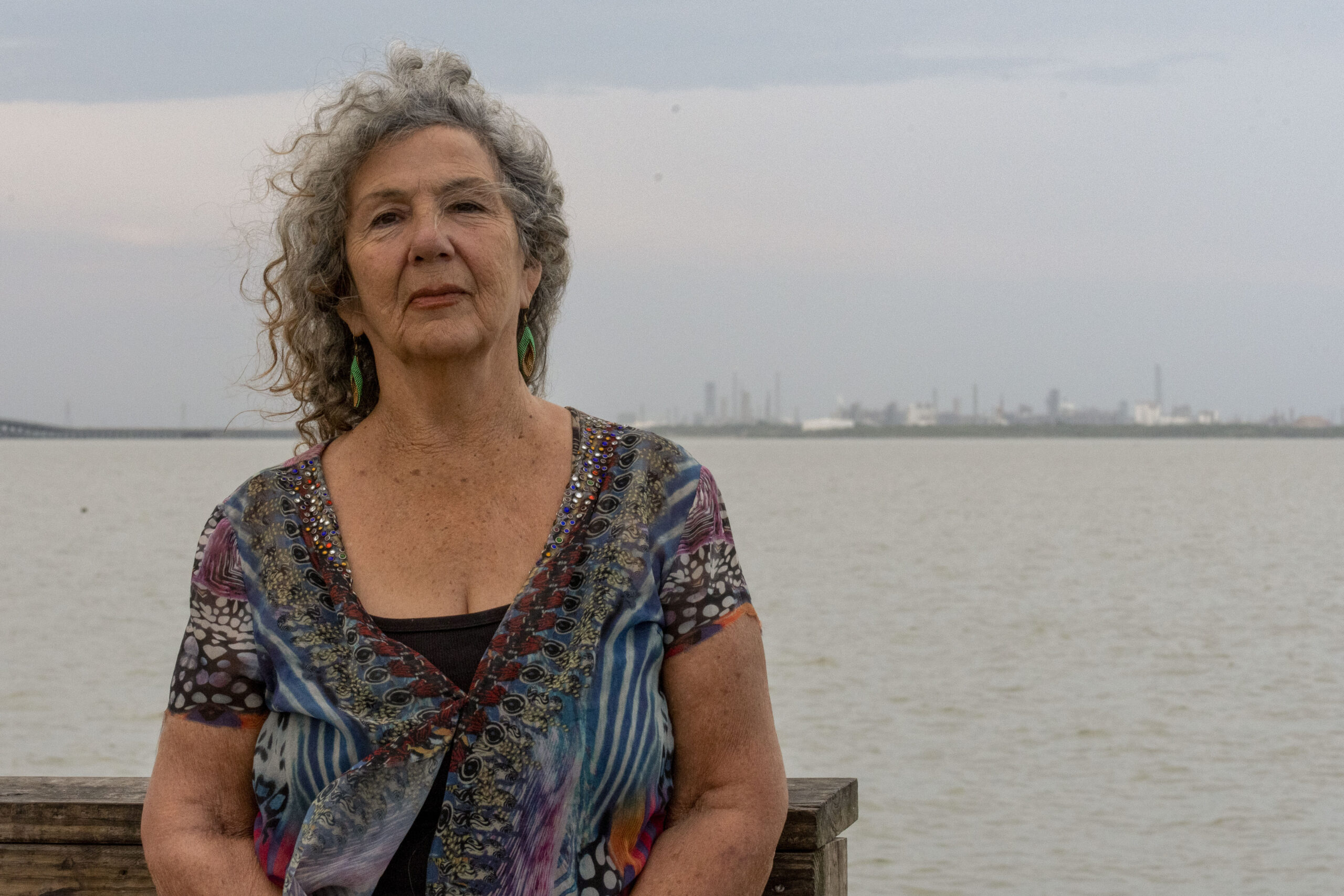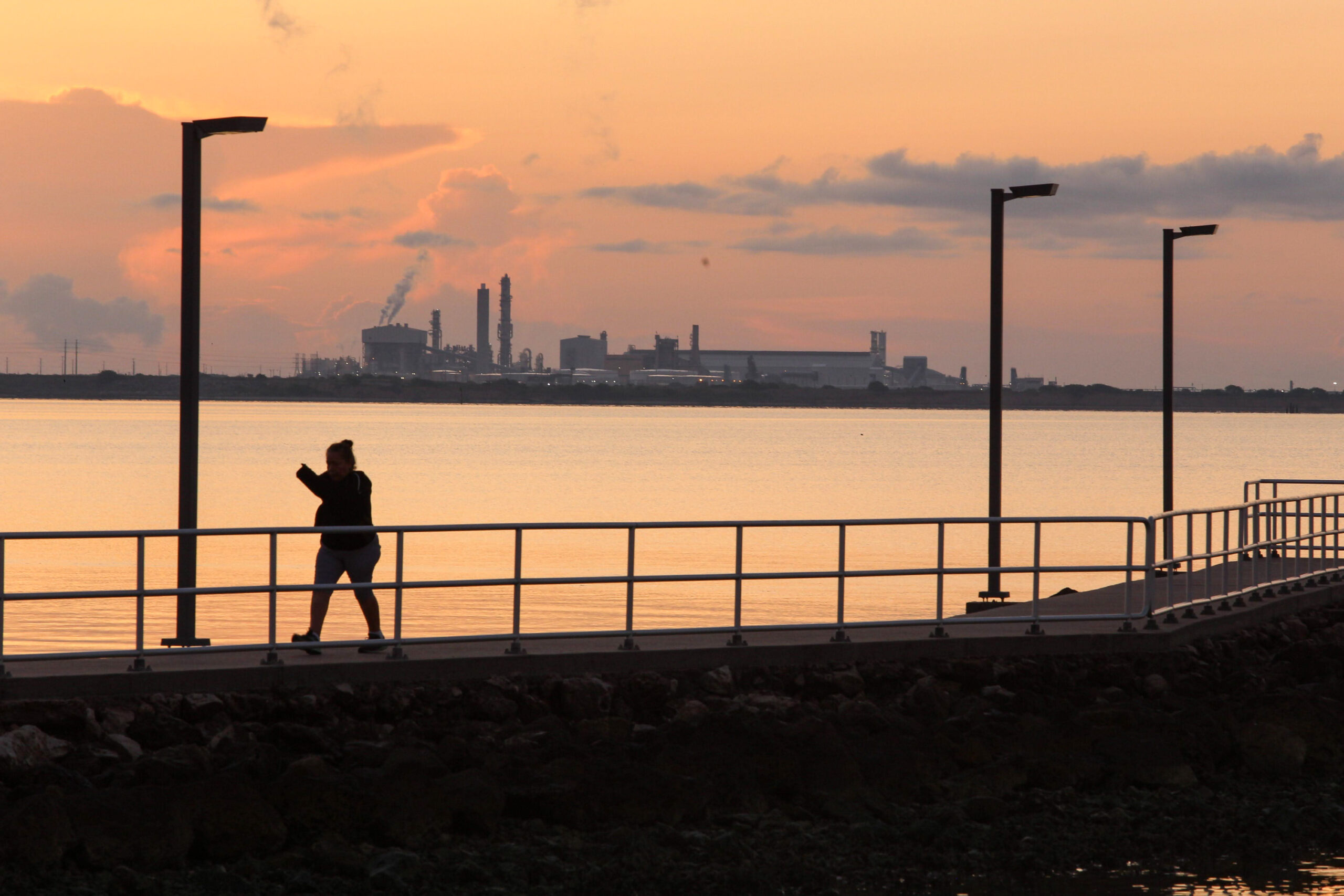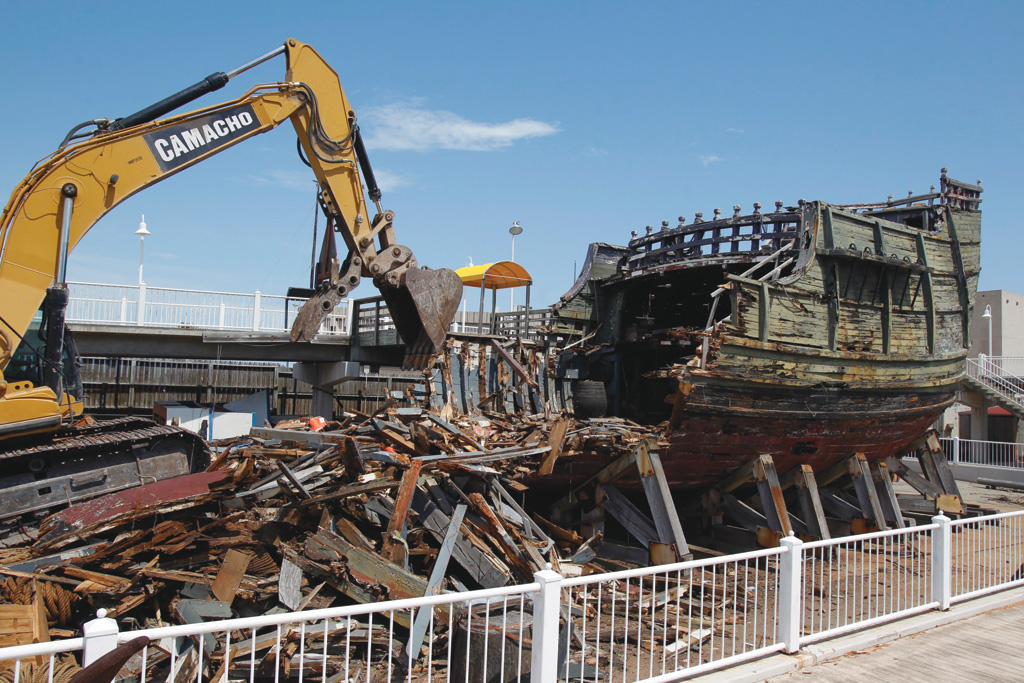
Ship Shape
For two decades, replicas of Christopher Columbus’ 1492 fleet of ships has carried the burden of dramatizing the Hispanic role in Corpus Christi.
A version of this story ran in the January 2015 issue.
Above: Demolition crews dismantle the Santa Maria at the Corpus Christi Museum of Science and History in August 2014.
The most agonizing episode in Corpus Christi’s convoluted politics of ethnic commemoration involved a set of borrowed reconstructions of long-destroyed artifacts lacking any concrete connection with Corpus Christi and South Texas. This was fitting, since Corpus Christi had no pre-Texas Revolution structures or places—no missions, presidios, courtyards, or plazas—with a direct, powerful association with the Spanish or Mexican past. For two decades starting in the 1990s, Spanish-built replicas of Christopher Columbus’ 1492 fleet, the most generic representation imaginable of the Spanish presence in the Americas, carried the burden of dramatizing the Hispanic role in Corpus Christi.
The quincentenary in 1992 of Columbus’ first voyage revealed the extent to which historical consciousness had transformed in many countries over the past decades. Attentiveness to the disease, destruction, and conquest that Columbus set in motion made it no longer possible to celebrate the explorer unabashedly. The Spanish government, on the other hand, used the event to attract positive attention. Among its activities, the Spanish commissioned reconstructions of the Niña, Pinta, and Santa Maria, meticulously researched and magnificently crafted at a cost of over $6.5 million. After visits to European ports, the Spanish sent las carabelas under sail across the Atlantic, where they toured North American ports in conjunction with an estimated 1,500 quincentenary events held throughout the United States. In March 1992, during a 10-day stay in Corpus Christi, Texas’ official quincentenary city, the fleet drew an estimated 106,000 people, its largest U.S. crowds. This reception, along with enthusiastic lobbying, convinced Spanish authorities that “the citizenry’s pride in its Hispanic past” qualified Corpus Christi as a long-term home for the replicas. The Washington-based Spain ’92 Foundation spurned more lucrative offers and accepted $1.6 million to lend the fleet to Corpus Christi.
The quincentenary in 1992 of Columbus’ first voyage revealed the extent to which historical consciousness had transformed in many countries over the past decades.
All the while, Hispanic groups expressed consternation that a “power struggle” within the fleet association had diverted las carabelas from their “future” as “a historical, cultural and economic joint venture with tremendous potential among Spain and the United States,” in the words of Fernando Iglesias, a Spanish-born Corpus Christi businessman prominent in the campaign to secure the ships. The enthusiastic involvement of the League of United Latin American Citizens, the Spanish American Genealogical Association, and the Westside Business Association in South Texas’ quincentenary celebration was a major reason that the Spanish assumed that the replicas would succeed in Corpus Christi. Of 18 members of the 1992 Quincentenary Commission, 11, including Iglesias, were Hispanic. But of 25 members of the initial board of directors of the Columbus Fleet Association formed in 1993, seven had Hispanic surnames. Including Iglesias and Janet Rice, chair of the Quincentenary Commission, only four members of the 1992 commission continued as directors of the Columbus Fleet Association. At the time of the 1994 barge collision, 10 of 32 board members were Hispanic.
This discontinuity arose largely from the need—once the goal became to make the ships a permanent exhibit—to involve the Greater Corpus Christi Business Alliance and the city government, represented by Rick Stryker, director of the city-run Corpus Christi Museum of Science and History. Still, a sense that downtown establishment figures had displaced the project’s initiators lay behind some of the divisiveness that disconcerted Spain’s representatives. In April 1993, as negotiations for the ships verged on success, unease over “the great danger of ill-feeling when some are given more credit than others” prompted Rice to prepare memoranda for the fleet association chair, William H. Crook, director of the VISTA (Volunteers in Service to America) program and later an ambassador during Lyndon Johnson’s administration, that detailed events and participating groups back to 1987, when state Senator Carlos Truan had arranged the invitation for las carabelas. Rice wanted Crook to be “fully informed of the effort and the participation that went into that great event which so united our city and strengthened our ties to Spain.” Rice eventually left the fleet association board, persuaded that it had undermined the goodwill established between the Quincentenary Commission and the Spanish.
Fearful of “municipal embarrassment” should the Spanish make good on their repossession threat, city officials and the business alliance devised a bailout package that included $2.9 million for a dry dock connected to the Corpus Christi Museum of Science and History, where people could tour the damaged Pinta and Santa Maria; the Niña would remain in the bay. The shipwrights’ repair work, it was hoped, would both attract visitors and offer a history lesson. At the city’s acquisition of the ships in 1993, Mayor Mary Rhodes lauded them as having symbolic value that went “way beyond any kind of monetary tag.” A year later, the city wavered on guaranteeing its own bailout.
In April 1994, an ocean barge plowed into the Pinta, which rammed the Santa Maria. The two ships suffered over $1.5 million in damage.
Meanwhile, starting in 1990, when it opened an exhibition of artifacts from the famed 1554 Spanish shipwreck off Padre Island, the Corpus Christi Museum of Science and History had shifted its emphasis toward Spanish-colonial exhibits with tourist potential. A product of the junior museum movement of the mid-twentieth century, the museum was built in the 1960s as a locally oriented municipal agency with close ties to the public schools, and for decades, it charged no admission fees. Around the time when the city lobbied the Spanish for the Columbus ships, the museum acquired Seeds of Change, a Smithsonian exhibition on the environmental and agricultural dimensions of the Columbian Encounter. Despite qualms over such a shift away from its educational and local-service mission, the museum wove the three exhibitions—the shipwreck, the ships, and the Seeds of Change—into a “World of Discovery” display that opened in May 1995. “In one visit,” the curator Don Zuris told the Corpus Christi Caller-Times, “a visitor can see the whole effect of 500 years of European contact.”
The city tried to keep the Columbus fleet and its debts separate from the museum and its finances. The museum raised its admission from a nominal $3, implemented in 1990, to $7 and then to $8 for adults, a prohibitive amount for many Corpus Christi families. The bulk of these added fees went to the fleet association, which operated as a sort of subcontractor or lessee within the museum. The arrangement had turned “a potentially catastrophic situation” into “a world-class attraction,” the association’s new director remarked hopefully in May 1995. Attendance at the museum jumped by 13 percent but soon stagnated. This drop happened despite determined promotion, including a ten-week truck tour by the Niña around Texas, a trip deplored by Spanish officials as potentially damaging to the only one of the three ships still seaworthy. The Spanish further complained that the fleet association had diverted the insurance settlement from the barge accident to operating expenses and debts. On top of all that, the Spanish insisted, the Santa Maria and the Pinta could have been repaired in the water. This implied that the $2.9 million dry dock had been a waste from the start. Worse, it had subjected the ships to dry rot and termites. When, in July 1997, an arbitrator ruled that the fleet was entitled only to $1.7 million in insurance compensation for the accident, not the $2.2 million to $2.3 million it had sought, the spiral into bankruptcy became uncontrollable. Right after Columbus Day in 1999, the museum closed access to the ships and rolled its entry fee back to $5.
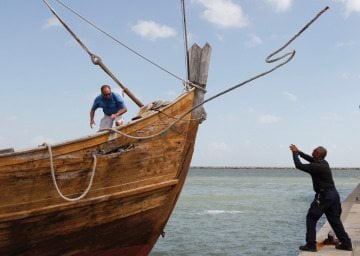
The Caller-Times expected Spain to “send the repo man to reclaim the barcos.” In January 2000, philanthropist Dusty Durrill intervened by filing a lien that in effect seized the ships as collateral for a $1 million loan that he had guaranteed seven years earlier as part of the arrangement to acquire the fleet. Durrill now found himself in a thankless position, a target of criticism for his involvement in decisions in the mid-1990s that contributed to the impasse at decade’s end. In addition to his loan guarantee, Durrill had advanced hundreds of thousands from his foundation to bring the ships and keep them running. As fleet association chair in the aftermath of the April 1994 barge accident, Durrill had helped arrange the bailout that included the dry dock. Durrill responded to Spanish and local criticism by recalling the fleet association’s struggle to find a contractor willing to repair the ships in the manner that the Spanish advised: “We sent out 102 bids and got back three—nobody wanted to work on wooden ships.” To a New Yorker reporter, Durrill insisted that he and others saw the fleet at the time as “a major visible flag-flyer for our tourism industry.” “The Columbus ships were a perfect way to tell” the story of Spain in the Americas, he added. “And why not in Corpus Christi?”
The New Yorker cited an unnamed “Hispanic leader” who labeled Durrill’s approach a “well-meaning” throwback to the days of the Anglo “patron.” Ethnic politics played a huge role in the decision to pursue the Columbus fleet, in dubious measures taken to retain them, and in bickering over their management. Still, the New Yorker erred in depicting Durrill as representative of old patterns of condescension. In the risks he took to bring the ships to the city and keep them there, he acted in line with his long-standing cooperation with Hispanic civic groups on heritage projects. The fundamental miscalculation was the notion that the ships would provide Corpus Christi “a particularly dramatic link to its own heritage,” a notion shared across ethnic lines. Corpus Christi’s ties to imperial Spain are too abstract to ensure that Mexican American identity would rally around replicas of Columbus’ ships, no matter how exquisitely crafted.
Spanish Embassy attorneys sued to have the liens removed, but Durrill staved off repossession long enough for the city government to work out a new bailout package. The Columbus exhibition reopened in May 2001. The city would draw on the hotel-motel tax for the bonds for the exhibition plaza and dry dock in a manner that was supposed to free up more money for the ships. A $3 supplement tacked back onto the museum’s admission price would cover insurance and maintenance, which the city would henceforth oversee. This deepened a relationship with which the museum’s staff had never been comfortable. Stryker, a professional curator with experience in Michigan and Delaware before coming to Corpus Christi in 1985, had expressed concern from the start that his role as the city’s voice in the fleet association would conflict with his responsibilities to the museum. Indeed, the ships’ supporters accused Stryker of looking out for the museum, to their detriment. “I’ve been in the museum business for 25 years,” Stryker remarked in 2000, “and I’ve never had people hate my guts so” as they did over the dry dock fiasco.
Fearful of “municipal embarrassment” should the Spanish make good on their repossession threat, city officials and the business alliance devised a bailout package that included $2.9 million for a dry dock connected to the Corpus Christi Museum of Science and History.
At the time las carabelas reopened in May 2001, the museum also opened a Gallery of Cultural Encounters, featuring a 32-foot domed wooden ceiling built in Castile in the 1530s and acquired from the Philadelphia Museum of Art in 1995. As with the Columbus ships, the ceiling was a beautiful work of craftsmanship with no links to Corpus Christi. The former Caller-Times publisher Ed Harte and his wife donated $1 million for the display hall, whose initial exhibit featured artifacts from the ill-fated La Salle expedition to Matagorda Bay in the 1680s. According to Stryker, the museum planned ultimately to use the hall to display material on the regional influence of the Karankawas, the French, and the Spanish.
The museum struggled until 2005, when an advisory group drafted a revised mission statement conceding that the municipal museum would concentrate in a general way on South Texas as “the cultural crossroads of the New World.” Portions of the advisory group’s proposal for a “Hispanic Heritage Center” addressed the modern and urban experience of the region’s Mexican-descended majority, but the document emphasized exploration and settlement. Of the nineteen collections the proposal listed as supporting regional Hispanic study, four focused on Corpus Christi after the 1926 opening of the port. From $8 for adults when the Columbus fleet reopened in 2001, the museum’s entry fee had risen to $11.50 by 2010, $9 for senior citizens, and $6 for children over five.
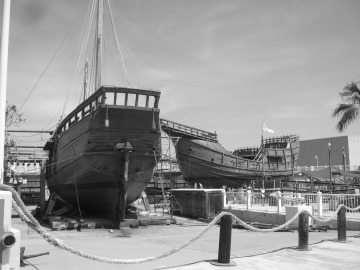
Upon director Stryker’s retirement in 2012, the city contracted with a company run by Dusty Durrill’s son, Bill, who ran a number of entertainment ventures, to manage the museum. The younger Durrill promised to hold the line on ticket prices, remodel the building, maintain accreditation and professional staff, and implement “kid-friendly” interactive exhibitions on regional history and ecology. Relieved to be rid of a financial, administrative, and political burden, the city agreed to a profit-sharing arrangement that included a municipal subsidy during the transition period. The deal caught the attention of curators and directors around the country, who noted how unusual it was to contract the operation of a public museum to a private company. Standard American practice would have suggested a public partnership with a foundation or a nonprofit organization, the arrangement in place for over 40 years at the museum’s neighbor, the Art Museum of South Texas. Exhausted after years of struggle and apprehensive about the new management, the bulk of the staff resigned or asked for transfers to other municipal agencies. The museum’s role as a low-key educational and civic institution for the community had long fallen by the wayside.
“The problem isn’t that the Columbus ships closed,” Stryker observed in October 2000, during the impasse caused by the Spanish repossession threat and Dusty Durrill’s lien. “It’s that they didn’t go away.” The ships’ condition remained heartbreaking; any visitor could perceive the Pinta and Santa Maria decaying in dry dock in the early 2010s. They had become a monument not to interethnic pride, but to the perils of community building through generalized symbolism. In 2013, Bill Durrill conceded the failure of his father’s vision: the dry-docked ships “have been an albatross around the museum’s neck for a long time.” If the city cannot give them away, the younger Durrill remarked, it should consider demolishing them.
[Editor’s note: The Pinta and the Santa Maria were demolished in August 2014. The ships’ ballasts were sold, and the revenue used to repair the Niña, which is now docked at the Lawrence Street T-Head marina in Corpus Christi.]
Excerpted with permission from Where Texas Meets the Sea: Corpus Christi and Its History (copyright © 2015 by the University of Texas Press) by Alan Lessoff, forthcoming in February 2015. For information visit www.utexaspress.com.
